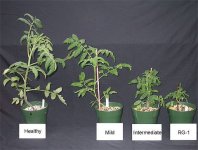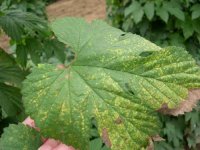Bongstar420
Member
Erhemm...oops
Double post
...but here is this:
http://www.apsnet.org/publications/apsnetfeatures/Pages/Viroids.aspx
I can put sap from dud branch onto a wound on tomato to see what it does......though I'm not sure I have anything which is classic duding. If its root rot, I doubt I will see further development.
Hop stunt viroid (HSVd)
In fact, of 200 hop clones tested from the USDA-ARS National Clonal Germplasm Repository (NCGR; Corvallis, OR), 98 entries tested positive for one or more viruses, 50% of which tested positive for AHLV infection and 29% tested positive for ApMV infection, the two viruses that tested positive in the NMSU-ASC Farmington experimental plots (Postman et al., 2005). The USDA-ARS NCGR has since eliminated viruses from most of their Humulus collection through tissue culture methods (Postman et al., 2005).
I was in that lab during the start of the tissue culture program. Did greenhouse maintenance for them.
Also, I've scouted a few dozen hops yards at least 10 times. There are what you could call dud vines on the mound where a vine looks weak with very short nodes and extra branching...sometimes the dud vines are free of disease or insect for the most part.
I've seen at least half a dozen of virus like symptoms out in the fields...nothing gets away from spray too..ever
See the Sterling hop leaf. I know a field with that virus..its most of the field. The grower didn't care and said it does nothing even tough the vines look crappy.
This is something about the PNW and pot growers...the hops industry has established an enormous pool of disease.. PM anywhere around hops is atrocious unless you get a good microclimate and a resistant cultivar. We found PM in Nugget 2 years back. Nugget was grown for decade or better with 0 PM ever. I was in the field with the first documented case of PM on Nugget ever in history.
It may not be coincidental that hops get a stunt viriod. It shortens vines, causes branching/branch dieback, weakens plants, lowers flower weight, lowers essence output, causes lifecycle changes, and has a highly differential expression rate...finally it has low persistence in soil and is sporadically transmitted
Double post
...but here is this:
http://www.apsnet.org/publications/apsnetfeatures/Pages/Viroids.aspx
I can put sap from dud branch onto a wound on tomato to see what it does......though I'm not sure I have anything which is classic duding. If its root rot, I doubt I will see further development.
Hop stunt viroid (HSVd)
In fact, of 200 hop clones tested from the USDA-ARS National Clonal Germplasm Repository (NCGR; Corvallis, OR), 98 entries tested positive for one or more viruses, 50% of which tested positive for AHLV infection and 29% tested positive for ApMV infection, the two viruses that tested positive in the NMSU-ASC Farmington experimental plots (Postman et al., 2005). The USDA-ARS NCGR has since eliminated viruses from most of their Humulus collection through tissue culture methods (Postman et al., 2005).
I was in that lab during the start of the tissue culture program. Did greenhouse maintenance for them.
Also, I've scouted a few dozen hops yards at least 10 times. There are what you could call dud vines on the mound where a vine looks weak with very short nodes and extra branching...sometimes the dud vines are free of disease or insect for the most part.
I've seen at least half a dozen of virus like symptoms out in the fields...nothing gets away from spray too..ever
See the Sterling hop leaf. I know a field with that virus..its most of the field. The grower didn't care and said it does nothing even tough the vines look crappy.
This is something about the PNW and pot growers...the hops industry has established an enormous pool of disease.. PM anywhere around hops is atrocious unless you get a good microclimate and a resistant cultivar. We found PM in Nugget 2 years back. Nugget was grown for decade or better with 0 PM ever. I was in the field with the first documented case of PM on Nugget ever in history.
It may not be coincidental that hops get a stunt viriod. It shortens vines, causes branching/branch dieback, weakens plants, lowers flower weight, lowers essence output, causes lifecycle changes, and has a highly differential expression rate...finally it has low persistence in soil and is sporadically transmitted
Attachments
Last edited:




 this guy again. put up or shut up. if you are able to do this document it. share the info or bounce fool no one cares how cool you think yyou are. and most of us that are really doing this think you sound like a fool and a liar. please prove us wrong.
this guy again. put up or shut up. if you are able to do this document it. share the info or bounce fool no one cares how cool you think yyou are. and most of us that are really doing this think you sound like a fool and a liar. please prove us wrong. 